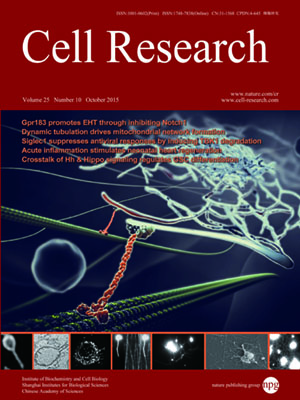
Volume 25, No 10, Oct 2015
ISSN: 1001-0602
EISSN: 1748-7838 2018
impact factor 17.848*
(Clarivate Analytics, 2019)
Volume 25 Issue 10, October 2015: 1152-1170
ORIGINAL ARTICLES
Ci antagonizes Hippo signaling in the somatic cells of the ovary to drive germline stem cell differentiation
Chaoyi Li1,*, Lijuan Kan1,*, Yan Chen2,*, Xiudeng Zheng3, Weini Li1, Wenxin Zhang1, Lei Cao2, Xiaohui Lin2, Shanming Ji1, Shoujun Huang1, Guoqiang Zhang1, Xiaohui Liu2, Yi Tao3, Shian Wu2 and Dahua Chen1
1State Key Laboratory of Reproductive Biology, Institute of Zoology, Chinese Academy of Sciences, Datun Road, Chaoyang, Beijing 100101, China
2State Key Laboratory of Medicinal Chemical Biology and College of Life Sciences, Nankai University, Tianjin 300071, China
3Centre for Computational and Evolutionary Biology, Institute of Zoology, Chinese Academy of Sciences, Beijing 100101, China
Correspondence: Dahua Chen, E-mail: chendh@ioz.ac.cn; Shian Wu,(wusa@nankai.edu.cn)
Many stem cell populations are tightly regulated by their local microenvironment (niche), which comprises distinct types of stromal cells. However, little is known about mechanisms by which niche subgroups coordinately determine the stem cell fate. Here we identify that Yki, the key Hippo pathway component, is essential for escort cell (EC) function in promoting germline differentiation in Drosophila ovary. We found that Hedgehog (Hh) signals emanating primarily from cap cells support the function of ECs, where Cubitus interruptus (Ci), the Hh signaling effector, acts to inhibit Hippo kinase cascade activity. Mechanistically, we found that Ci competitively interacts with Hpo and impairs the Hpo-Wts signaling complex formation, thereby promoting Yki nuclear localization. The actions of Ci ensure effective Yki signaling to antagonize Sd/Tgi/Vg-mediated default repression in ECs. This study uncovers a mechanism explaining how subgroups of niche cells coordinate to determine the stem cell fate via Hh-Hippo signaling crosstalk, and enhances our understanding of mechanistic regulations of the oncogenic Yki/YAP signaling.
10.1038/cr.2015.114
FULL TEXT | PDF
Browse 2223


